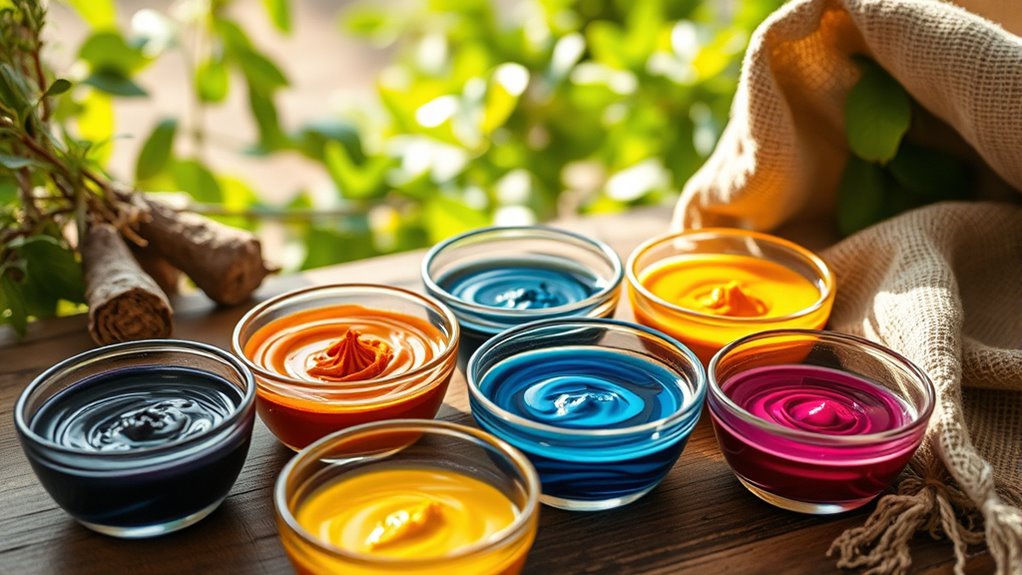Eco-friendly dyes and natural pigments offer a sustainable alternative to conventional coloring methods by using plant-based, biodegradable materials that reduce environmental harm and promote ethical practices. They support responsible sourcing, minimize water and energy use, and produce vibrant, durable colors. Choosing these options helps conserve ecosystems and encourages eco-conscious manufacturing. If you want to understand how these dyes can positively impact the environment and your products, there are more details to explore ahead.
Key Takeaways
- Eco-friendly dyes are derived from natural sources like plants, minerals, and renewable resources, reducing environmental impact.
- Natural pigments offer vibrant, durable colors with improved colorfastness, suitable for various textiles.
- Sustainable sourcing practices ensure minimal habitat disruption and promote biodiversity preservation.
- Low impact processing techniques reduce water, energy, and chemical use, decreasing pollution and carbon footprint.
- Choosing eco-friendly dyes supports responsible manufacturing, water conservation, and promotes a circular, environmentally conscious industry.

Eco-friendly dyes are transforming the textile industry by offering sustainable alternatives to traditional chemical dyes. When you choose eco-friendly dyes, you’re supporting practices that emphasize sustainable sourcing, meaning the raw materials are obtained in ways that preserve ecosystems and respect local communities. These dyes often come from natural pigments derived from plants, minerals, and other renewable resources, reducing dependence on synthetic chemicals that can harm the environment. By prioritizing sustainable sourcing, manufacturers minimize environmental degradation and promote biodiversity, ensuring that the harvesting of dye materials doesn’t lead to deforestation or habitat loss. This approach not only benefits the planet but also encourages ethical practices across the supply chain.
Low impact processing plays a *crucial* role in making eco-friendly dyes more appealing and practical for your use. Unlike traditional dyeing methods that consume large amounts of water, energy, and toxic chemicals, low impact processing techniques aim to reduce resource consumption and emissions. This might involve using less water during dye application, employing natural mordants, or utilizing innovative methods like cold dyeing, which requires minimal energy. When you opt for products made with low impact processing, you’re helping to decrease the carbon footprint associated with textile production, promoting a more sustainable future. These methods also often produce less wastewater containing harmful chemicals, making the entire process safer for workers and nearby communities.
Natural pigments used in eco-friendly dyes are increasingly versatile and vibrant, proving that sustainability doesn’t mean sacrificing color quality. You can find dyes made from indigo, madder root, turmeric, and other plant-based sources that yield rich, lasting colors. Advances in natural dye technology have improved colorfastness and brightness, making these dyes suitable for a wide range of textiles. Additionally, because these pigments are biodegradable, they break down naturally once disposed of, reducing long-term environmental impact. This not only aligns with eco-conscious values but also allows you to embrace fashion and textiles that are healthier for the planet.
Choosing eco-friendly dyes means supporting a shift towards more responsible production practices. You’re encouraging companies to adopt sustainable sourcing and low impact processing, which together help conserve water, reduce pollution, and promote fair labor practices. As awareness grows, more brands are investing in research and development to make natural pigments more accessible and durable. By making conscious choices in your clothing and textile products, you actively contribute to reducing environmental harm, fostering a circular economy, and protecting the planet for future generations. Eco-friendly dyes aren’t just a trend—they’re a *vital* step toward a cleaner, more sustainable textile industry.
Frequently Asked Questions
Are Eco-Friendly Dyes Suitable for All Fabric Types?
Eco-friendly dyes aren’t suitable for all fabric types, as fabric compatibility varies. You should consider the specific material and its dye fixation techniques to guarantee vibrant, long-lasting results. For example, natural fibers like cotton and silk usually work well, but synthetic fabrics may require different methods or treatments. Always test small samples first and use appropriate fixation techniques to achieve the best dye adherence and colorfastness.
How Long Do Natural Pigments Retain Their Color?
Natural pigments can last as long as a well-kept secret, with their color fastness often lasting decades if properly cared for. Their pigment stability depends on factors like exposure to sunlight and washing, which can fade their hue over time. With gentle handling, you can preserve their vibrant beauty, but understanding their limitations helps you maintain the richness of their colors longer.
Are Natural Dyes More Expensive Than Synthetic Ones?
Natural dyes are generally more expensive than synthetic ones due to the cost comparison, and ingredient sourcing plays a significant role. You’ll find that natural dyes often require higher-quality ingredients and more labor-intensive processes, which drive up prices. While synthetic dyes are cheaper and easier to produce, natural dyes offer eco-friendly benefits. If you’re environmentally conscious, the higher cost may be worth it for the sustainable and natural qualities they provide.
Can Eco-Friendly Dyes Produce Vibrant, Long-Lasting Colors?
Yes, eco-friendly dyes can produce vibrant, long-lasting colors. While you might face colorfastness challenges initially, recent dyeing process innovations help improve durability and vibrancy. These advancements guarantee your natural dyes resist fading over time, making your fabrics both beautiful and sustainable. By choosing the right techniques, you can achieve rich, lasting hues without compromising eco-friendliness, giving you vibrant results that stand the test of time.
What Are the Environmental Impacts of Producing Natural Pigments?
Producing natural pigments has some environmental impacts you should consider. It involves resource consumption, like water and land, which can strain ecosystems. You might face biodegradability challenges because some pigments don’t break down easily, leading to waste accumulation. While natural pigments are generally better for the environment, it’s essential to oversee their production carefully to minimize resource use and ensure they degrade properly, reducing long-term environmental harm.
Conclusion
Just like a gardener tending to a delicate, thriving plant, choosing eco-friendly dyes nurtures our planet’s health. Each vibrant color you select is a drop of rain in a vast, parched landscape, reviving and preserving its beauty. When you embrace natural pigments, you become a guardian of the Earth’s palette, ensuring future generations can enjoy the same vivid hues. Your choices are seeds of change, cultivating a more sustainable world, one colorful step at a time.










